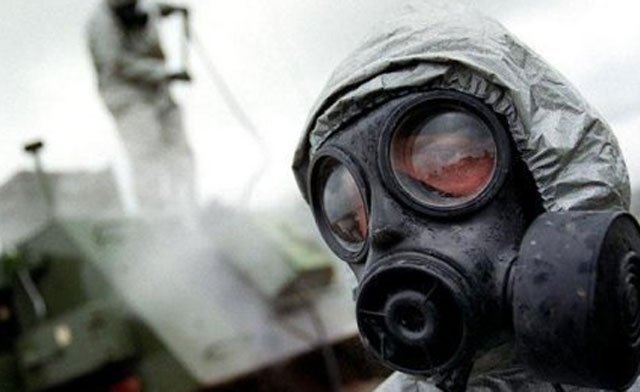
Sarin, one of a group of nerve gas agents invented by German scientists as part of Hitler’s preparations for World War II, is an extremely toxic substance that disrupts the nervous system, overstimulating muscles and vital organs.
It can be inhaled as a gas or absorbed through the skin. In high doses, Sarin suffocates its victims by paralyzing the muscles around their lungs. Sarin was called “the poor man’s atomic bomb” due to large number of people that can be killed by a small amount.
One hundred milligrams of Sarin (about one drop) can kill the average person in a few minutes if he or she’s not given an antidote.
Sarin, or GB, or Isopropylmethanefluorophosphonate, is an organophosphorus compound with the formula [(CH3)2CHO]CH3P(O)F. It is a colorless, odorless liquid.
Sarin was discovered in 1938 in Wuppertal-Elberfeld in Germany by two German scientists attempting to create stronger pesticides; it is the most toxic of the four G-agents made by Germany.
The compound, which followed the discovery of the nerve agent tabun, was named in honor of its discoverers: Schrader, Ambros, Rüdiger and Van der Linde.

In mid-1939, the formula for the agent was passed to the chemical warfare section of the German Army Weapons Office, which ordered that it be brought into mass production for wartime use. A number of pilot plants were built, and a high-production facility was under construction (but was not finished) by the end of World War II.
Experts say Sarin is more than 500 times as toxic as cyanide.
Like other nerve agents, Sarin functions by competitive inhibition of the enzyme acetyl cholinesterase. This enzyme is found at synapses and nerve endings where it breaks hydrolyses the neurotransmitter Acetyl choline so that the nerve impulse is only transmitted once as required. When the enzyme is inhibited acetyl choline accumulates at nerve endings. This has various unpleasant effects leading to paralysis (where accumulation occurs at motor neurones) and eventually death by means such as asphyxiation.
Initial symptoms following exposure to sarin are a runny nose, tightness in the chest and constriction of the pupils. Soon after, the victim has difficulty breathing and experiences nausea and drooling. As the victim continues to lose control of bodily functions, the victim vomits, defecates and urinates. This phase is followed by twitching and jerking. Ultimately, the victim becomes comatose and suffocates in a series of convulsive spasms.
Death may follow in one minute after direct ingestion of a lethal dose unless antidotes, typically atropine and pralidoxime, are quickly administered.
Huge secret stockpiles of Sarin were built up by superpowers during Cold War.
Sarin can only be manufactured in a laboratory, but does not require very sophisticated equipment.